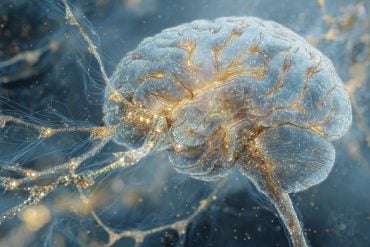Summary: The brain’s meningeal lymphatic system plays a key role in clearing waste and transporting immune cells, but until now, how it develops was unclear. Using zebrafish and advanced imaging, researchers revealed that neural activity regulates this system by influencing specialized glial cells that release Vegfc, a key growth factor.
These glial cells, along with fibroblasts that help process Vegfc, guide the formation and precise placement of lymphatic vessels, ensuring they remain confined to the meninges. This neural-glia-fibroblast interaction prevents harmful immune invasion into brain tissue, showcasing the brain’s ability to coordinate its own microenvironment.
Key Facts
- Neural Activity Drives Development: Increased neural activity boosts brain meningeal lymphatic development through Vegfc-expressing glial cells.
- Glia-Fibroblast Cooperation: Vegfc must be processed by fibroblasts to guide lymphatic vessel growth precisely at the brain surface.
- Protective Barrier: This regulatory axis ensures lymphatic vessels do not invade the brain parenchyma, preventing immune disruptions.
Source: Chinese Academy of Science
Over the past decade, intensive studies have shown that the brain’s meningeal lymphatic system acts as the brain’s “waste disposal network,” maintaining homeostasis by clearing metabolic waste and transporting immune cells.
However, the mechanism underlying its developmental regulation remains unknown. How does this intricate system form, and which cells or signals govern its specific spatial arrangement in the meninges?

A study published in Cell and led by Dr. Du Jiulin’s lab at the Institute of Neuroscience, Center for Excellence in Brain Science and Intelligence Technology of the Chinese Academy of Sciences has uncovered the core regulatory mechanism of brain meningeal lymphatic system development.
Taking advantage of in vivo long-term imaging in zebrafish, in combination with genetic manipulations and neural activity studies, researchers found that increasing neural activity—for example, visual stimulation—significantly enhances the development of mural lymphatic endothelial cells (muLECs) in the leptomeninges, while inhibiting neural activity—for example, visual deprivation—leads to a significant reduction in the muLEC number.
Focusing on Vegfc, a key factor necessary for lymphatic system development, researchers identified a specific glial subpopulation—slc6a11b+ RAs—that expresses Vegfc.
These cells extend fibers to the brain surface, making them the main source of Vegfc in the brain. Deletion of slc6a11b+ RAs impaired muLEC development, while upregulating these cells’ Vegfc signaling enhanced muLEC development.
Moreover, researchers found that the activity of slc6a11b+ RAs and their Vegfc expression levels are positively regulated by neural activity. They found that the precursor Vegfc (pro-Vegfc) secreted by slc6a11b+ RAs requires the cooperation of ccbe1+ fibroblasts to be converted into its mature form (mVegfc).
This cross-tissue collaboration precisely restricted the distribution of mVegfc to the brain-meningeal interface, ensuring that lymphatic endothelial cells were confined to the brain surface, preventing their invasion into the brain parenchyma, which could cause immune disruptions.
The study shows that the brain acts as a coordinator of its microenvironment, and reveals a novel neural-glia-fibroblast-lymphatic regulatory axis. This provides a new framework for understanding how the brain adapts its lymphatic network based on functional needs, and explains why the brain’s meningeal lymphatic system remains confined to the meninges, avoiding invasion of the brain parenchyma.
In the future, intervening in this regulatory network may offer new perspectives on the role of the meningeal lymphatic system in neurological diseases and developing treatments.
About this neuroscience research news
Author: Liu Jia
Source: Chinese Academy of Science
Contact: Liu Jia – Chinese Academy of Science
Image: The image is credited to Neuroscience News
Original Research: Open access.
“Neural-activity-regulated and glia-mediated control of brain lymphatic development” by Du Jiulin et al. Cell
Abstract
Neural-activity-regulated and glia-mediated control of brain lymphatic development
The nervous system regulates peripheral immune responses under physiological and pathological conditions, but the brain’s impact on immune system development remains unknown.
Meningeal mural lymphatic endothelial cells (muLECs), embedded in the leptomeninges, form an immune niche surrounding the brain that contributes to brain immunosurveillance.
Here, we report that the brain controls the development of muLECs via a specialized glial subpopulation, slc6a11b+ radial astrocytes (RAs), a process modulated by neural activity in zebrafish.
slc6a11b+ RAs, with processes extending to the meninges, govern muLEC formation by expressing vascular endothelial growth factor C (vegfc). Moreover, neural activity regulates muLEC development, and this regulation requires Vegfc in slc6a11b+ RAs.
Intriguingly, slc6a11b+ RAs cooperate with calcium-binding EGF domain 1 (ccbe1)+ fibroblasts to restrict muLEC growth on the brain surface via controlling mature Vegfc distribution.
Thus, our study uncovers a glia-mediated and neural-activity-regulated control of brain lymphatic development and highlights the importance of inter-tissue cellular cooperation in development.






